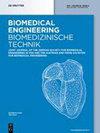A method to classify bone marrow cells with rejected option
IF 1.8
4区 医学
Q4 ENGINEERING, BIOMEDICAL
引用次数: 2
Abstract
Abstract Bone marrow cell morphology has always been an important tool for the diagnosis of blood diseases. Still, it requires years of experience from a suitable person. Furthermore, the outcomes of their recognition are subjective and there is no objective quantitative standard. As a result, developing a deep learning automatic classification system for bone marrow cells is extremely important. However, typical classification machine learning systems only produce classification answers, and will not refuse to generate predictions when the prediction reliability is low. It will pose a big problem in some high-risk systems such as bone marrow cell recognition. This paper proposes a bone marrow cell classification method with rejected option (CMWRO) to classify 11 bone marrow cells. CMWRO is based on convolutional neural networks, ICP and SoftMax (CNN-ICP-SoftMax), containing a classifier with rejected option. When the rejected rate (RR) of tested samples is 0.3143, it can ensure that the precision, sensitivity, accuracy of the accepted samples reach 0.9921, 0.9917 and 0.9944 respectively. And the rejected samples will be handled by other ways, such as identified by doctors. Besides, the method has a good filtering effect on cell types that the classifier is not trained, such as abnormal cells and cells with less sample distribution. It can reach more than 82% in filtering efficiency. CMWRO improves the doctors’ trust in the results of accepted samples to a certain extent. They only need to carefully identify the samples that CMWRO refuses to recognize, and finally combines the two results. It can greatly improve the efficiency and accuracy of bone marrow cell recognition.一种具有拒绝选项的骨髓细胞分类方法
骨髓细胞形态学一直是血液病诊断的重要工具。不过,这需要一个合适的人有多年的经验。此外,他们的识别结果是主观的,没有客观的定量标准。因此,开发一种深度学习的骨髓细胞自动分类系统是非常重要的。然而,典型的分类机器学习系统只产生分类答案,在预测可靠性较低时不会拒绝生成预测。在一些高风险的系统中,如骨髓细胞识别,这将带来很大的问题。提出了一种基于拒绝选项(CMWRO)的骨髓细胞分类方法,对11种骨髓细胞进行分类。CMWRO基于卷积神经网络、ICP和SoftMax (CNN-ICP-SoftMax),包含一个带有拒绝选项的分类器。当检测样品的拒绝率(RR)为0.3143时,可保证接受样品的精密度、灵敏度、准确度分别达到0.9921、0.9917和0.9944。不合格的样品将通过其他方式处理,例如由医生鉴定。此外,该方法对分类器未训练的细胞类型,如异常细胞和样本分布较少的细胞有很好的过滤效果。过滤效率可达82%以上。CMWRO在一定程度上提高了医生对接受样本结果的信任度。他们只需要仔细识别CMWRO拒绝识别的样品,最后将两种结果结合起来。它可以大大提高骨髓细胞识别的效率和准确性。
本文章由计算机程序翻译,如有差异,请以英文原文为准。
求助全文
约1分钟内获得全文
求助全文
来源期刊
CiteScore
3.50
自引率
5.90%
发文量
58
审稿时长
2-3 weeks
期刊介绍:
Biomedical Engineering / Biomedizinische Technik (BMT) is a high-quality forum for the exchange of knowledge in the fields of biomedical engineering, medical information technology and biotechnology/bioengineering. As an established journal with a tradition of more than 60 years, BMT addresses engineers, natural scientists, and clinicians working in research, industry, or clinical practice.

 求助内容:
求助内容: 应助结果提醒方式:
应助结果提醒方式:


